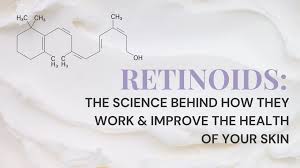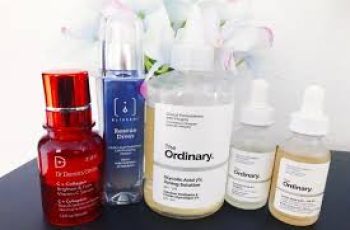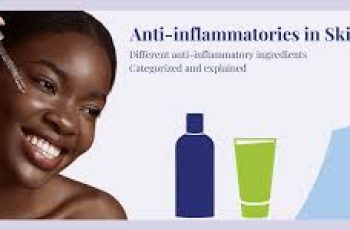
Retinoid Science in Skincare
To understand how retinol works, you must first realize that retinol is in a family of compounds called retinoids. Retinoids are a family of compounds that all bind the Retinoic Acid Receptor (RAR) and RXR receptors.1 The RAR and RXR receptors are found in the nucleus of skin cells (both keratinocytes and fibroblasts) and many other types of cells.2 The following image will help you understand the retinoid science we will discuss in this article.
For simplicity, I will discuss retinoid effects on the skin cells called fibroblasts, but retinoids work on many different cell types (including keratinocytes in the epidermis). I will only discuss the RAR receptors because RXR receptors are confusing and less important when discussing how retinoids work for wrinkles, acne and dark spots. In this article, I will use the word “retinol” but it can be exchanged with the words retinoid, tretinoin, Retin A, or other names of retinoids. In other words- all retinoids work the same way. So- lets look inside skin cells and discuss – what does retinol do?
Do All Retinoids Work The Same Way?
When retinoids get into the skin, they all turn into all trans-retinoic acid- also called ATRA. So yes- retinoids all work the same way. However, there are several things that differentiate retinoids used in skincare:
Retinoids strength varies by both the type of retinoid and the retinoid percentage strength.
The entire skincare routine will affect how well retinoids work- so make sure you are using a skin care routine personalized for your Baumann Skin Type®.
The type of retinoid affects how well the retinoid penetrates into the skin. Retinaldehyde (also called retinal) and retinoid esters like retinyl palmitate do not absorb into the skin as easily as tretinoin and retinol absorb. The diagram below shows that retinyl esters do not penetrate well into the skin, but when they do- they are converted to retinol. Retinol, tretinoin, and retinaldehyde are all converted to retinoid acid (ATRA) inside the cell cytoplasm.
How Does Retinol Work?
Retinoids pass through the protective outer layers of the skin to the dermis where they enter the cytoplasm of the fibroblast skin cell. Once inside the cytoplasm, all retinoids convert to All Trans Retinoic Acid (ATRA). ATRA then enters the cell nucleus with help from cellular retinoic acid-binding proteins (CRABP). When ATRA binds RAR receptors, they are activated to recognize “retinoic acid response elements (RARE) on the DNA. This enables them to alter gene expression.
Once the RAR receptor is bound by a retinoid, different pathways get turned on that have predictable effects. Activation of the RAR receptor by ATRA causes some genes to turn on and some genes to turn off.3 Think of the RAR receptor as a lock and the retinoid ATRA as the key. When the key fits in the lock- some genes get turned on and some get turned off.
The strength of a retinoid depends upon it ability to get to the cell nucleus and stimulate the RAR receptors. Retinoid percentages affect this ability. Stronger retinoids will work better than weaker retinoids to prevent and treat aging skin. Let’s look at how retinoids treat different skin problems.
How Does Retinol Work on Skin Problems?
When retinoids turn on and off genes, many good things happen. This discussion will be simplified and limited to retinol’s effects on the skin. We will look at how retinol (and other retinoids) work on wrinkles, acne and dark spots on the skin. It is so exciting how much is known about how retinoids work!
How Does Retinol Work On Wrinkles?
Retinoids protect skin from aging, pollution, vaping and smoking.4 Before I discuss how retinoids work on wrinkles5, you need to understand a bit about skin aging.6
Skin Aging
When ultraviolet light (sun), pollution, smoking, vaping, or free radicals touch the skin, certain genes are turned on and off. Inflammation also affects gene expression leading to an increased risk of skin aging. There are many genes that are affected by these insults, but we are going to focus on the genes that cause skin to wrinkle, thin, and age. Aged skin, also called mature skin, has less collagen, hyaluronic acid and elastin than young skin.
Aging skin occurs for two reasons:
Decreased production of collagen, hyaluronic acid and elastin
Increased breakdown of collagen, hyaluronic acid and elastin
The diagram below shows how sun, pollution, inflammation and free radicals turn on these genes, leading to a decrease in the number of important skin components like collagen. The green arrows mean activation, while the red arrows mean inhibition. If you want to learn more in-depth science about why skin ages- click here.
How Retinoids Prevent Skin Aging
Retinoids prevent skin aging including wrinkles, sagging, skin thinning and skin fragility7 by:
Turning on genes that produce collagen8, hyaluronic acid and elastin*.
Turning off genes that make enzymes that break down the structure components9 that make skin look young, tight, smooth, resilient, and strong.
Retinoids block enzymes such as:
Collagenase10
Matrix metalloproteinases (MMPs)
Elastase11
Gelatinase12
Retinoids Get Rid Of Wrinkles You Already Have
In addition to preventing wrinkles as discussed above, retinoids also improve wrinkles by increasing levels of collagen and hyaluronic acid. They do this by turning on the genes that are needed to make collagen and hyaluronic acid.
Retinoids and Collagen
Younger skin has more Type 1 and Type 3 collagen than mature skin.13 The goal of any antiaging skin care routine is to increase the amount of collagen in the skin. Retinoids have been shown in dozens of studies over the last 3 decades to increase skin collagen.14 For this reason, many dermatologists suggest beginning retinoids in your 20s to prevent skin aging.
Does Retinol Improve Sagging Skin?
Skin sags when it loses a protein called elastin.15 Retinol does not increase amounts of active elastin. Although retinoids stimulate the genes to make more elastin precursors, these immature elastin fibers do not assembly on the microfibrillar backbones needed for the elastin fibers to be functional.16 At this time- no cosmeceutical ingredients can improve sagging skin on the face or body. However, retinoids can prevent skin sagging by preserving functional elastin.
undefined
Which is better for wrinkles- tazarotene or tretinoin?
Tazarotene 0.1% is stronger so it is the best retinoid to treat wrinkles. Both tazarotene 0.1% and tretinoin 0.1% are good for wrinkles.
How Do Retinoids Work On Acne?
Retinoids were approved to treat acne before they were used to treat photoaging of the skin.
Retinoids are the core and most important skin care products used in the treatment of acne therapy today.17 They are the preferred treatment of acne by dermatologists because they treat many of the causes of acne. Retinoids treat and prevent acne by:
Blocking inflammation by affecting toll like receptors, lowering inflammatory cytokines, and inhibiting other inflammatory pathways
Toll like receptors (TLR) are turned on by a bacteria known as Cutibacterium acnes. When C. acnes stimulate the TLR, inflammation occurs by triggering cytokines such as TNF-alpha, IL-8 and others. The retinoid all trans retinoic acid (ATRA) blocks the activation of the TLR, preventing inflammation from C. acnes bacteria. (Remember that all retinoids turn into ATRA in the skin so retinol, tretinoin, adapalene and tazarotene all have this effect.)
Regulating desquamation which prevents clogged pores and comedones
Desquamation is regulated by epidermal growth factors (EGF) which is increased by ATRA. EGF activates stem cells in the basal layer of the skin, prompting them to speed up their cell division to produce new skin cells and pushing old skin cells to the skin’s surface resulting in a more orderly and increased speed of desquamation. The increased desquamation helps unclog comedones (blackheads).
How Retinoids Work On Dark Spots On The Skin
Dark spots on the skin and uneven skin tone can be caused by age, sun exposure, melasma or inflammation.
Retinoids help improve dark spots and even skin tone through two main mechanisms:
Inhibition of tyrosinase
Tyrosinase is the enzyme needed to make the skin pigment melanin. Tyrosinase can be blocked to reduce skin pigment production. Retinoids have been shown to block tyrosinase in light skin types, but in black skin they are less effective.18 Treating darks spots in black skin and dark brown skin requires the addition of other tyrosinase inhibitors.
Increasing desquamation
Increasing desquamation leads to the exfoliation of pigmented skin cells. If newly produced skin cells have less, pigment, then the skin will lighten. Using exfoliation to lighten skin only works when the pigment-producing cells (melanocytes) are turned off. Retinoids will increase desquamation in all skin colors. Darker skin types must use retinoids carefully to avoid retinoid side effects that could result in inflammation and increased pigmentation.
Retinoids are often combined with tyrosinase inhibitors and mild steroids in a “Triple Combination Cream” to increase exfoliation, block tyrosinase and decrease inflammation. Tri-Luma® is a triple combination cream (TCC) that must be prescribed by a physician. Your doctor may also write a recipe for a compounding pharmacy to customize a triple combination cream for you. These TCC creams are often called “Bleach-Eze” although this is not an official brand name. They are also called “melasma creams”. Triple combination creams are the most effective way to lighten the skin and even skin tone. Combining a TCC with a tinted sunscreen and a PAR-2 blocker is the best treatment for dark spots on the skin. Ask your dermatologist about prescription TCCs to use in your skin care routine to treat hyperpigmentation.
Summary of Retinoid Science
Whether you have skin aging, acne, or dark spots on the face- retinoids can help. It is critical to use retinoids properly and in the correct step in your skincare routine to avoid side effects. Be patient because retinoids do not work immediately.


